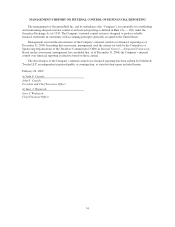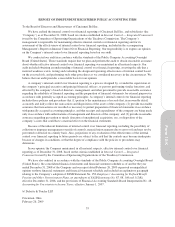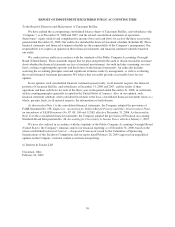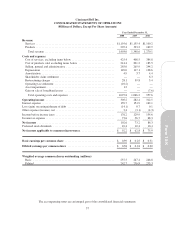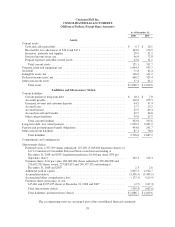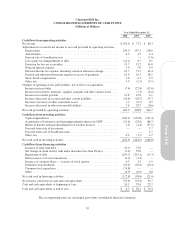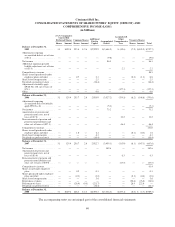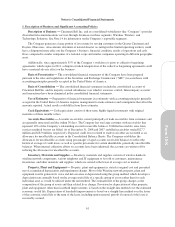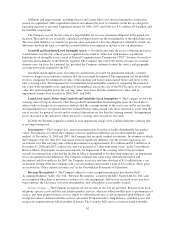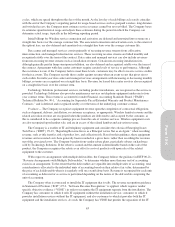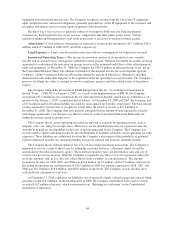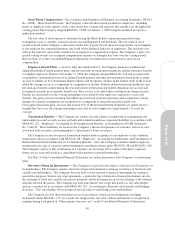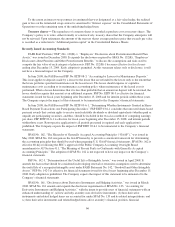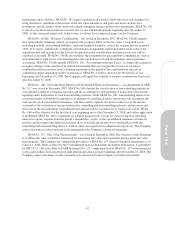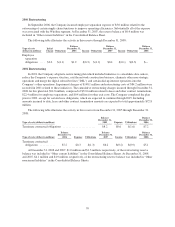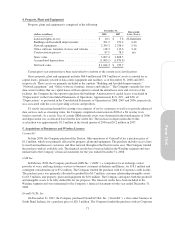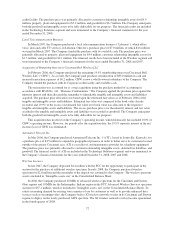Cincinnati Bell 2008 Annual Report Download - page 163
Download and view the complete annual report
Please find page 163 of the 2008 Cincinnati Bell annual report below. You can navigate through the pages in the report by either clicking on the pages listed below, or by using the keyword search tool below to find specific information within the annual report.
cycles, which are spread throughout the days of the month. As the last day of each billing cycle rarely coincides
with the end of the Company’s reporting period for usage-based services such as postpaid wireless, long distance,
and switched access, the Company must estimate service revenues earned but not yet billed. The Company bases
its estimates upon historical usage and adjusts these estimates during the period in which the Company can
determine actual usage, typically in the following reporting period.
Initial billings for Wireline service connection and activation are deferred and amortized into revenue on a
straight-line basis over the average customer life. The associated connection and activation costs, to the extent of
the upfront fees, are also deferred and amortized on a straight-line basis over the average customer life.
Data center and managed services consist primarily of recurring revenue streams from collocation,
interconnection, and managed infrastructure services. These recurring revenue streams are billed monthly and
recognized ratably over the term of the contract. Data center and managed services can also include revenues
from non-recurring revenue streams such as installation revenues. Certain non-recurring installation fees,
although generally paid in lump sum upon installation, are also deferred and recognized ratably over the term of
the contract. Agreements with data center customers require certain levels of service or performance. Although
the occurrence is rare, if the Company fails to meet these levels, customers may be able to receive service credits
for their accounts. The Company records these credits against revenue when an event occurs that gives rise to
such credits. In multi-year data center and managed services arrangements with increasing or decreasing monthly
billings, revenues are recognized on a straight-line basis. Revenue for leased data center assets is also recognized
on a straight-line basis over the contract term.
Technology Solutions professional services, including product installations, are recognized as the service is
provided. Technology Solutions also provides maintenance services on telephony equipment under one to four
year contract terms. This revenue is accounted for under Financial Accounting Standards Board (“FASB”)
Technical Bulletin No. 90-1, “Accounting for Separately Priced Extended Warranty and Product Maintenance
Contracts,” and is deferred and recognized ratably over the term of the underlying customer contract.
Products — The Company recognizes equipment revenue upon the completion of contractual obligations,
such as shipment, delivery, installation, or customer acceptance, as appropriate. Wireless handset revenue and the
related activation revenue are recognized when the products are delivered to and accepted by the customer, as
this is considered to be a separate earnings process from the sale of wireless services. Wireless equipment costs
are also recognized upon handset sale, and are in excess of the related handset and activation revenue.
The Company is a reseller of IT and telephony equipment and considers the criteria of Emerging Issues
Task Force (“EITF”) 99-19, “Reporting Revenue Gross as a Principal versus Net as an Agent,” when recording
revenue, such as title transfer, risk of product loss, and collection risk. Based on this guidance, these equipment
revenues and associated costs have generally been recorded on a gross basis, rather than recording the revenues
net of the associated costs. The Company benefits from vendor rebate plans, particularly rebates on hardware
sold by Technology Solutions. If the rebate is earned and the amount is determinable based on the sale of the
product, the Company recognizes the rebate as an offset to costs of products sold upon sale of the related
equipment to the customer.
With respect to arrangements with multiple deliverables, the Company follows the guidance in EITF 00-21,
“Revenue Arrangements with Multiple Deliverables,” to determine whether more than one unit of accounting
exists in an arrangement. To the extent that the deliverables are separable into multiple units of accounting, total
consideration is allocated to the individual units of accounting based on their relative fair value, determined by
the price of each deliverable when it is regularly sold on a stand-alone basis. Revenue is recognized for each unit
of accounting as delivered or as service is performed depending on the nature of the deliverable comprising the
unit of accounting.
The Company often is contracted to install the IT equipment that it sells. The revenue recognition guidance
in Statement of Position (“SOP”) 97-2, “Software Revenue Recognition,” is applied, which requires vendor
specific objective evidence (“VSOE”) in order to recognize the IT equipment separate from the installation. The
Company has customers to which it sells IT equipment without the installation service, customers to which it
provides installation services without the IT equipment, and also customers to which it provides both the IT
equipment and the installation services. As such, the Company has VSOE that permits the separation of the IT
63
Form 10-K



